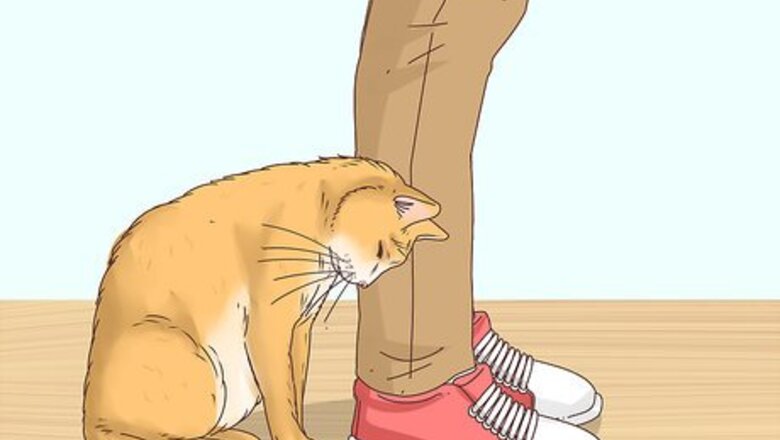
views
Analyzing the Cat’s Behavior
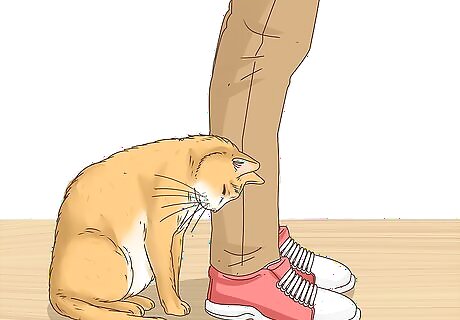
See if the cat approaches you. A cat’s behavior towards people can be a big indicator of whether or not a cat is a stray. Since stray cats have once been socialized, meaning they’ve been around people and most likely lived in a home, they are often not as skittish as feral cats. Stand or sit near the cat and see if it approaches you on its own. If it does, it is probably a stray that is lost. Crouch down to its level. This may be less intimidating for the cat. Also pay attention to whether or not the cat approaches houses or cars on its own. Stray cats are more likely to do this.
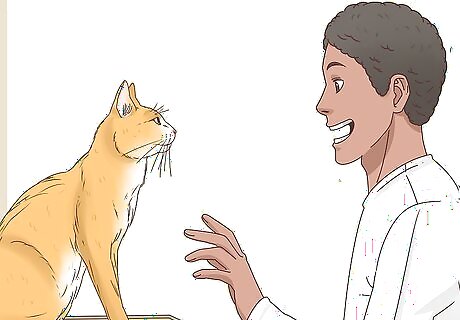
Approach the cat. If the cat does not come up to you on its own, try approaching it. It could be the cat is socialized, but is too frightened to come up to you. Try moving toward the cat slowly, all the while talking to it in a soothing voice. If the cat lets you get close or pet it after some coaxing, it is probably a stray.
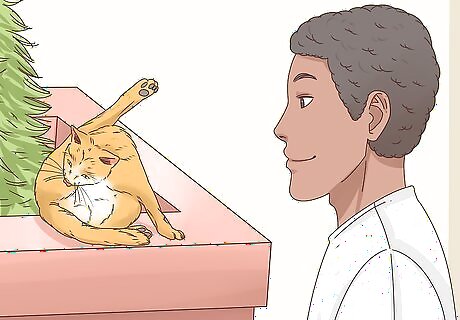
Determine if the cat is alone. Stray cats will generally be traveling alone, while feral cats often travel as part of a group. Watch to see if the cat is travelling with any other cats. If it is not, it is most likely a stray.
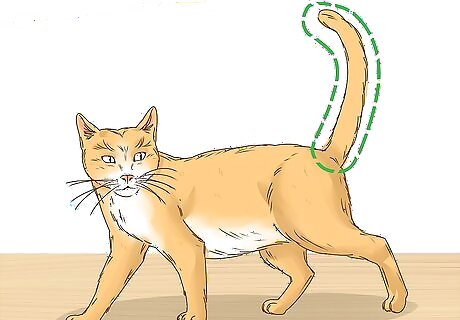
Watch its body language. A cat’s body language can also give you clues as to whether or not it is a stray. Stray cats will still exhibit similar body language to a domesticated house cat. Look for the following: Pay attention to how the cat walks. If it walks with its tail in the air, which is a friendly sign, it is probably a stray who has been a housecat at one time or another. However, if it often crawls or stays crouched to the ground, and keeps its tail low as a form of protection, it is probably a feral cat that has never had a home. Also, a stray cat will probably make eye contact with you while a feral cat will not.
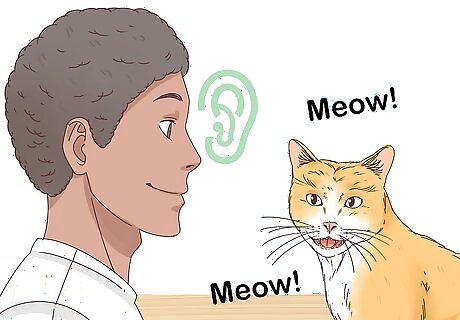
Listen to the cat. The type of vocalizations a cat makes is another way to tell if it is a stray. Stray cats will meow or “answer” you when you speak to them. Depending how long they have been gone from home or on their own, they may even purr when you come near them. Feral cats, on the other hand, don’t usually make any sounds.
Looking for Signs of an Owner

Look for a collar. Cats that have a home will most likely also have a collar. Most pet owners keep a collar on their cat that has their name and a phone number to call in case the cat is lost. If you think a cat might be a stray, check to see if it is wearing a collar. Just because a cat is not wearing a collar, does not mean it is a stray. It’s possible the cat lost its collar or was never given one.
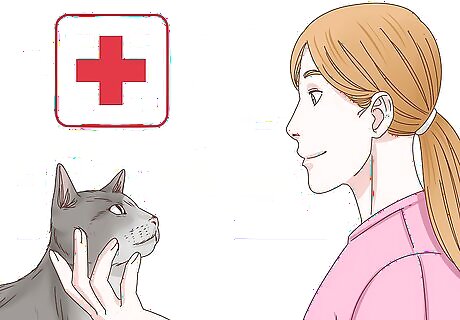
Check to see if the cat seems healthy. Another clue to whether or not a cat is a stray is its general health. Is the cat skinny and malnourished? Is it injured? Does it seem to be in distress? These can all be indications that the cat is a stray and is unable to find the food or help it needs. These factors can be tough to analyze, however. For example, maybe the cat appears to be well-nourished—you cannot see its ribs and it appears to be at a healthy weight—but it also seems very hungry. It’s possible this is a stray cat that has not been lost very long, but is hungry because it is not used to hunting its own food in the wild. On the other hand, perhaps you found a cat that seems skinny, but does not act hungry. It’s possible this cat is feral and has always lived outdoors. It does not act hungry because it knows how to find its own food, but it is not as well-nourished as a pet cat would be. Do your best to make a judgment that takes both its appearance and behavior into consideration.

Look at the condition of its coat. Stray cats are most likely going to look dirty and disheveled. Since they probably came from a home where they were kept inside and groomed on a regular basis, they probably won’t know how to keep this appearance up on their own. Feral cats’ coats are usually clean and well-kept, despite the fact that they live in the wild.
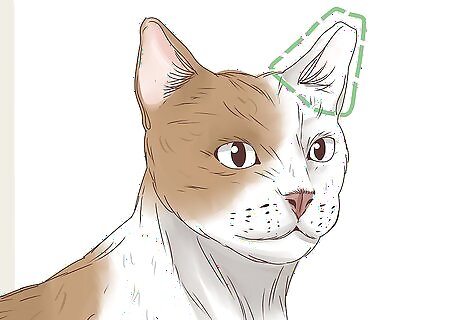
Look for a missing ear tip. When a cat is spayed or neutered, the doctor sometimes surgically removes the tip of one ear to signify this surgery has already been performed. This is done so that, if the cat becomes lost, it hopefully will not have to go through the trauma of an unnecessary surgery. If the cat you’ve found is missing the tip of one ear, it is possible it is a cat that has a family and is cared for.
Finding a Stray Cat’s Owner

Ask around your neighborhood. The only sure way to know whether or not a cat is a stray is to find its owner. A stray cat may not be far from its home. Attempt to locate its owner by asking your neighbors if they have lost a cat or know anyone who has. It may help to take a picture of the cat along with you. Posting a photo of the cat and a location where it was found on social media can also help you find the owner. This method will allow you to reach a bigger audience in much less time than going door-to-door. In addition, you can create a “found” poster with the cat’s picture and contact number to call if anyone recognizes the cat.
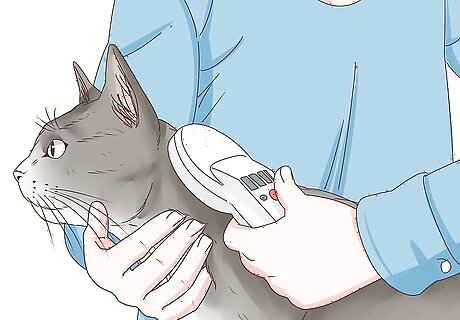
Check for a microchip. If you are able to safely catch the cat, take it to a veterinarian to have them scan the cat for a microchip. If the cat is implanted with a microchip, it will have information about the owner and how to contact them.
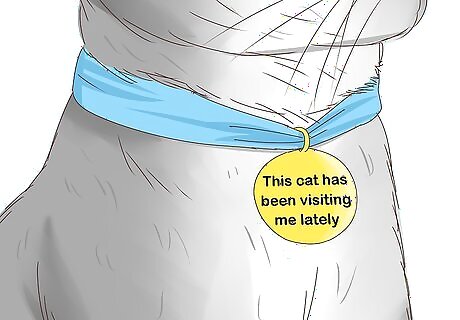
Attach a paper collar. It is also possible that the owner of the stray cat doesn’t know it has been wandering. In this situation, it can be helpful to attach a paper collar to the cat, if possible, that includes a message like, “This cat has been visiting me lately. Please contact me if it belongs to you.” Be sure to include your phone number or email address so the person can reach you. If the cat wanders around during the day but returns home at night, this will let the owner know what it is doing. Don’t leave the paper collar on for an extended period of time because it could be irritating to the cat. If you haven’t received any calls within a few days of placing it on the cat, remove it if the cat will allow you.

Contact local animal shelters. Check with the animal shelters in your area to see if anyone has called about a missing cat recently. If someone has, they may be able to give you the person’s contact information or contact them on their own to try and reunite the owner and cat. It is also a good idea to leave a description of the cat, where it was found, and your contact information with each shelter so they can get in touch with you if someone calls looking for a cat that matches your description.

Report the missing cat online. There are also online resources, like PetsLocated.com, that help reunite owners with their lost pets. This site has a “lost” database and a “found” database and it continually cross references the two to try and match up any pets that have been reported lost and also found. Enter the information you have about the cat on this database to help find the owner.




















Comments
0 comment